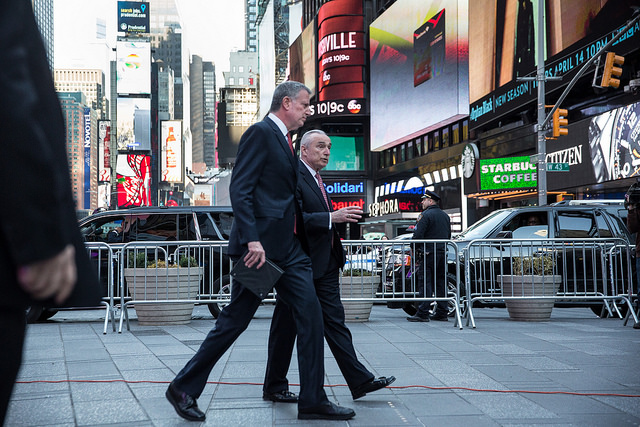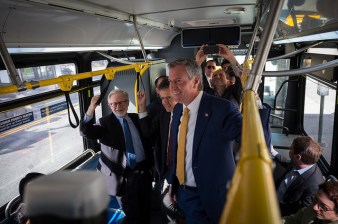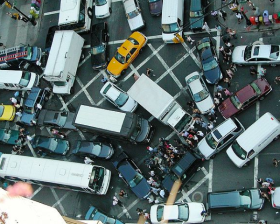Looking for a Bold Vision for NYC Streets? De Blasio’s Not Your Guy.
The mayor cares about preventing traffic deaths but has no broader appreciation for how diminishing the primacy of the car on city streets can make life better for New Yorkers.

Thanks to Politico for putting its scoop about Mayor de Blasio’s ruminations on the Times Square plazas up for public consumption. It’s a revealing glimpse into what the mayor says in private about one of the city’s most high-profile street transformations.
Sally Goldenberg and Dana Rubinstein take us back to 2015, when de Blasio and then-NYPD chief Bill Bratton, egged on by the tabloid front pages, were seriously considering turning the Broadway plazas in Times Square back into traffic lanes so tourists would no longer be confronted by painted breasts.
Here’s their recap of the FOILed email exchange between de Blasio and former Bloomberg chief of staff Peter Madonia:
Unlike several of his Bloomberg-era colleagues, Madonia, misspelling Sadik-Khan’s name, said the Times Square redesign was a “Bloomberg Jeanette Sadik Khan disaster based on lies that these malls, the bike lanes and street adjustments would reduce congestion.”
“Take it out,” Madonia continued. “No real New Yorkers use it and they hate walking thru it.”
De Blasio responded within half an hour.
“We are on the same wavelength,” he said, according to the emails obtained by POLITICO, via a Freedom of Information Law request. “Now, easier said than done. But very much on the table.”
Yes, because Real New YorkersTM would rather jab and kick their way through the impenetrable crowds of tourists on the old, narrow Times Square sidewalks, while inhaling tailpipe vapor from a hundred idling cars waiting for the traffic lights on Broadway to change.
You could give the mayor the benefit of the doubt and say he’s just humoring an acquaintance, but de Blasio’s unfiltered “wavelength” isn’t that much different from what he was saying in public.
Bratton, at the time, was complaining about Broadway as a “dead end” (which makes no sense if you’re walking), and de Blasio was open to the idea of removing the plazas. Why would anyone who cares about creating a good pedestrian environment even entertain the thought?
Under a different mayor, the realm of possibility for NYC streets would be more expansive. After last month’s motorized rampage that killed one person and injured dozens more, there might be serious discussions at City Hall about turning Seventh Avenue in Midtown into a street for buses and bikes only and limiting traffic on cross-streets to deliveries, so people can walk without worrying about the next random car attack.
De Blasio’s not that mayor. He has a genuine interest in preventing traffic deaths and he’s gone to bat for some important street safety projects. And those accomplishments count for a lot — New York City streets are significantly safer today because the mayor has directed DOT to engineer streets to reduce the risks of motor traffic. But he has no broader appreciation for how diminishing the primacy of the car on city streets can make life better for New Yorkers — that a low-car city is also a more affordable, accessible, productive, and enjoyable city.
If he did, the forthcoming “congestion plan” he’s ordered up would be a traffic reduction strategy that aims squarely at eliminating the city’s enormous and varied subsidies for parking. We’d be putting bus lanes on every avenue and bike corrals at every street corner, instead of sinking hundreds of millions of dollars into ferries. We’d have a working plan for a citywide protected bike lane network and pedestrianized blocks in every neighborhood, instead of a low-ridership streetcar route in development.
In a way, it’s impressive that anything of consequence has changed on de Blasio’s watch, given his general indifference to the experience of walking on city streets. Under a mayor with a stronger vision for a low-car city, much more could get done.


